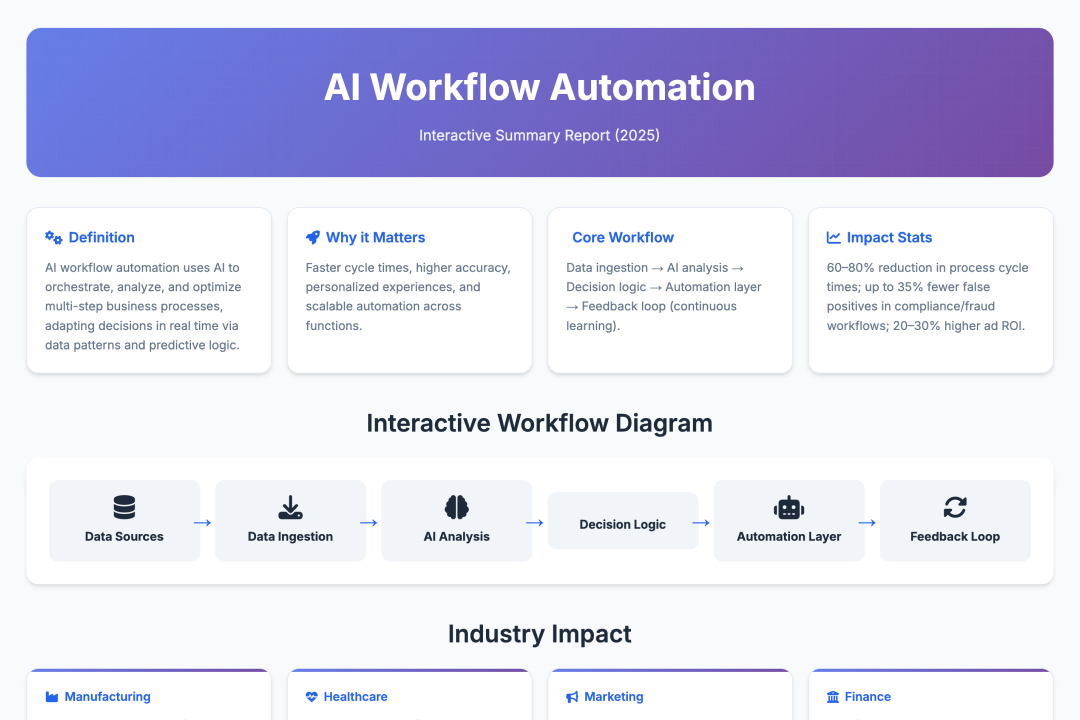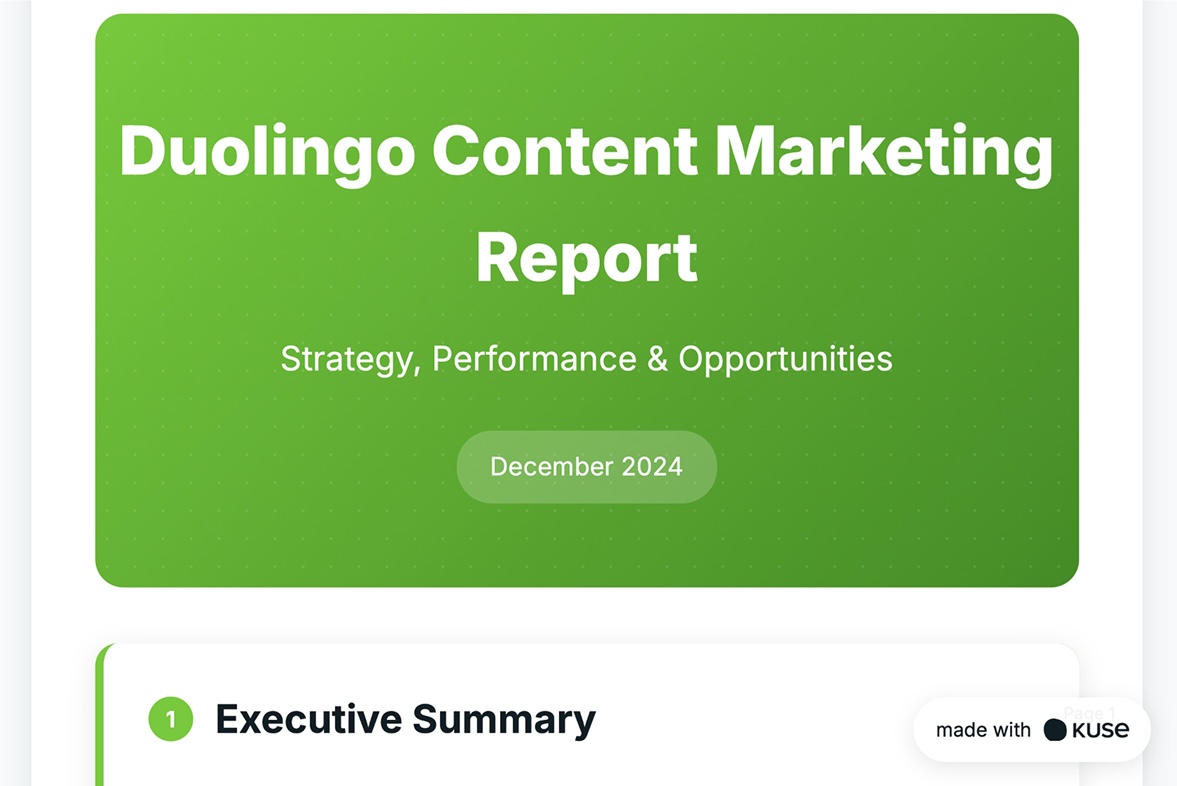What Is AI Workflow Automation and How to Build Smarter Business Pipelines in 2025
Discover what AI workflow automation means in 2025 and how to build an AI pipeline workflow that saves time, reduces costs, and delivers smarter business outcomes. Learn real examples, tools, benefits, and challenges across industries.

What Is AI Workflow Automation?
AI workflow automation refers to using artificial intelligence to orchestrate, analyze, and optimize business processes that were previously manual or rule-based.
Unlike conventional automation—which simply follows predefined triggers—AI-driven workflows adapt dynamically, using data patterns and predictive logic to make decisions in real time.
At its foundation, an AI pipeline workflow connects multiple moving parts:
- Data ingestion – Collecting raw data from CRM systems, IoT devices, emails, or databases.
- AI analysis – Applying machine learning, NLP, or computer vision to extract meaning and detect anomalies.
- Decision logic – Determining next actions through if/then reasoning or reinforcement models.
- Automation layer – Executing decisions across systems such as Salesforce, Slack, or ERP tools.
- Feedback loop – Learning continuously from new data to refine future performance.
Example: In a global retailer, an AI pipeline might analyze incoming support tickets, detect recurring product issues, automatically generate an internal alert to quality teams, and summarize weekly trends for leadership—all without human intervention.
Why AI Workflow Automation Matters in 2025
The growing complexity of digital operations has made intelligent automation a necessity rather than an upgrade. Here’s why it matters—and how it transforms work.
1. Speed and Efficiency
AI can process and route information at lightning speed. In finance or telecom operations, where human review might take hours, AI completes the same review in seconds.
By eliminating manual routing, repetitive approvals, and data entry, organizations save thousands of work hours annually.
A Deloitte survey found that companies deploying AI workflow automation reported a 60–80% reduction in process cycle times, improving both employee productivity and time-to-market.
2. Accuracy and Decision Confidence
Humans fatigue; algorithms don’t.
AI systems learn from historical data to make decisions with measurable accuracy. In logistics, predictive routing algorithms analyze weather patterns, driver data, and warehouse conditions to select the fastest, safest delivery path.
In compliance, AI reduces false positives in fraud detection by up to 35%, leading to faster, more confident decisions.
3. Personalization and Customer Experience
Consumers now expect hyper-personalized service. AI enables this by interpreting behaviors in real time—what users read, click, or ignore—and adjusting engagement instantly.
For instance, an AI-powered content workflow in a streaming platform might recommend tailored playlists based on not only listening history but also time of day and sentiment in user comments.
4. Scalability Across Departments
One model can support multiple teams.
An NLP engine used in marketing to summarize campaign performance can also help HR analyze survey responses or product teams summarize user reviews.
With cloud orchestration and no-code tools, AI workflows can scale across geographies and functions with almost no marginal cost.
Learn how to select the right orchestration tools in our next guide: Top AI Workflow Tools and Generators That Redefine Automation in 2025
Inside the AI Pipeline Workflow: How It Works
Each loop strengthens itself—making the system not only faster but also smarter over time.
Key Benefits Across Industries
Manufacturing
Factories use AI workflow automation to monitor sensor data and predict equipment failures. When vibration data exceeds a threshold, the AI pipeline automatically creates a maintenance order, assigns technicians, and updates ERP systems.
Result: 40% less unplanned downtime and lower maintenance costs.
Healthcare
Hospitals integrate AI into triage and patient-flow workflows. When a patient registers, AI reviews medical history, symptoms, and imaging scans to predict urgency and assign the right department.
In pharmaceuticals, AI orchestrates R&D workflows, automatically moving lab results into analytics dashboards and notifying scientists when anomalies arise.
Result: faster trials, reduced administrative load, and earlier diagnoses.
Marketing
AI pipelines analyze engagement data across channels. For example, an ai-powered content insight workflow can identify which ad creatives perform best for different demographics, automatically pause underperforming ads, and suggest optimized headlines.
Result: lower cost per acquisition and 20–30% higher ad ROI.
Finance
Financial institutions use AI workflows to connect anti-fraud systems, KYC databases, and transaction monitoring tools. When suspicious activity is detected, the AI pipeline triggers an internal review, updates audit logs, and alerts compliance officers.
Result: real-time fraud prevention and faster regulatory reporting.
Automotive and Dealerships
High-volume dealerships rely on ai-driven workflow automation tools for service communications and compliance. AI scans customer data to predict maintenance schedules, auto-generate reminders, and flag expiring warranties.
When integrated with a dealership management system (DMS), it can even route customers to the right service advisor or generate quotes automatically.
Result: increased repeat visits, faster compliance checks, and smoother communication.
Explore these industry-specific use cases in AI-Driven Workflow Automation in Dealerships: From Service Communications to Compliance.
How to Build an AI Workflow Pipeline Step by Step
- Identify and Map Processes
Start with high-volume, rule-based operations that depend on structured data—like invoice approvals, CRM updates, or lead scoring. - Choose AI Models for Each Task
Use classification models for sorting, NLP models for text analysis, and regression models for forecasting. Combine them through APIs or no-code orchestrators. - Integrate an AI Workflow Generator
Platforms like Whalesync, Pega, or Appian connect your AI logic with business systems such as Slack, Salesforce, or HubSpot. - Test, Measure, and Optimize
Pilot the workflow with limited datasets, monitor outcomes, and iterate on accuracy and latency metrics before scaling. - Monitor Governance and Compliance
Ensure each AI decision—especially in finance or healthcare—is explainable, logged, and auditable to meet regulatory standards.
Challenges and Considerations
Even the best workflows can fail without proper planning.
1. Data Quality and Silos
AI is only as good as the data it sees. Inconsistent schemas, missing labels, or siloed storage can distort results. Companies must invest in data hygiene pipelines and unified data lakes to ensure reliability.
2. Change Management
Employees often resist automation due to fear of replacement. Leaders should frame AI as an augmentation tool—relieving teams from repetitive work so they can focus on strategy, creativity, and customer relationships.
3. Compliance and Governance
Industries like healthcare, finance, and automotive require transparent audit trails. Implement explainable AI (XAI) frameworks to ensure every automated decision can be justified and reproduced.
4. Scalability and Integration
Many organizations underestimate the effort to connect legacy systems with new AI layers. The best practice is to start modular—automate one pipeline end-to-end, then expand horizontally.
5. Ethical Use and Bias
Training data can inherit bias. Regular model audits, bias detection tools, and human-in-the-loop validation are critical to maintain fairness and public trust.
AI workflow automation is moving from pilot projects to enterprise infrastructure. In 2025, leaders are no longer asking “Should we automate?” but “How do we orchestrate intelligence across our workflows?”
By mastering ai pipeline workflows, businesses can build systems that think, learn, and act—turning complexity into clarity and time into value.
Next read: Top AI Workflow Tools and Generators That Redefine Automation in 2025 — a deep dive into platforms that make this intelligent automation possible.
FAQs
1. What is AI workflow automation?
It’s the use of AI models and automation software to perform multi-step business processes—like document review or customer communication—without manual intervention, improving speed and accuracy.
2. What is an AI pipeline workflow?
An AI pipeline workflow connects data ingestion, model inference, and automation layers in a closed feedback loop that learns continuously from new outcomes.
3. How do AI workflows benefit small businesses?
They democratize automation. Even small teams can connect CRM data, chatbots, and analytics dashboards to automate reporting or customer follow-ups—saving time and reducing costs.
4. What tools can generate AI workflows automatically?
Tools like Whalesync, Appian, and Aisera act as ai workflow generators, connecting prebuilt AI functions (classification, summarization, sentiment analysis) with business apps.
5. What challenges do enterprises face when adopting AI workflow automation?
Typical issues include integrating legacy systems, maintaining data privacy, preventing model drift, and ensuring transparency for audits.
6. What industries gain the most from AI workflow automation?
Sectors like finance, healthcare, automotive, and e-commerce gain major ROI from predictive analytics, compliance monitoring, and personalized service pipelines.




